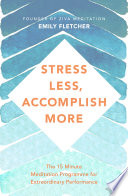

Understanding the physiological and psychological impacts of stress is crucial for managing it effectively. The book delves into how stress affects our brain and body, highlighting that stress is not merely a mental burden but a physical one that can lead to various health issues. It explains the fight-or-flight response, chronic stress, and how our bodies react to perceived threats. This foundational knowledge empowers readers to recognize their stress triggers and understand the importance of stress management techniques. By comprehending the science behind stress, individuals can take proactive steps to mitigate its effects and improve their overall well-being.
Continue readingA significant portion of the book is dedicated to the practice of mindfulness and meditation as effective tools for stress reduction. The author presents various techniques, including breath awareness, body scans, and guided imagery. These practices help cultivate present-moment awareness, allowing individuals to detach from stressors and reduce anxiety. The book emphasizes that regular mindfulness practice can lead to lasting changes in brain structure and function, enhancing emotional regulation and resilience. By incorporating these techniques into daily routines, readers can develop a more centered and balanced approach to life, ultimately leading to increased productivity.
Continue readingEffective time management is presented as a critical component of stress reduction. The author outlines various strategies, such as prioritization, scheduling, and the Pomodoro technique, which help individuals manage their tasks more efficiently. By learning to distinguish between urgent and important tasks, readers can allocate their time and energy more wisely, reducing the feeling of being overwhelmed. The book encourages the use of planners and digital tools to keep track of responsibilities while promoting the importance of taking breaks to recharge. This approach not only alleviates stress but also enhances productivity, allowing individuals to accomplish more in less time.
Continue readingThe connection between physical health and stress management is a key theme in the book. The author advocates for regular exercise, a balanced diet, and adequate sleep as foundational elements for reducing stress levels. The book explains how physical activity releases endorphins, which improve mood and combat stress. Additionally, it discusses the impact of nutrition on mental health, suggesting that certain foods can either exacerbate or alleviate stress. Sleep is emphasized as a critical factor in cognitive function and emotional stability. By adopting healthier lifestyle choices, readers can build resilience against stress and enhance their overall productivity.
Continue readingCultivating a positive mindset is presented as an essential strategy for managing stress and achieving goals. The book explores the concept of cognitive reframing, where individuals learn to view challenges as opportunities for growth rather than threats. This shift in perspective can significantly reduce stress levels and enhance motivation. The author provides practical exercises for fostering gratitude and optimism, which can lead to improved mental health and well-being. By focusing on the positive aspects of life and developing a growth mindset, readers can navigate stress more effectively and boost their overall productivity.
Continue readingThe importance of social connections in stress management is highlighted throughout the book. The author encourages readers to cultivate strong relationships with family, friends, and colleagues, as these support systems can provide emotional relief during stressful times. The book discusses the benefits of seeking help and sharing experiences with others, emphasizing that vulnerability can lead to deeper connections and a sense of belonging. Additionally, it addresses the role of mentorship and networking in personal and professional growth. By nurturing these relationships, individuals can create a safety net that helps them cope with stress more effectively.
Continue readingSetting achievable goals is crucial for maintaining motivation and reducing stress. The author emphasizes the importance of SMART goals (Specific, Measurable, Achievable, Relevant, Time-bound) and how they can provide clarity and direction. The book discusses the dangers of setting unrealistic expectations, which can lead to feelings of failure and increased stress. By breaking larger goals into smaller, manageable tasks, readers can experience a sense of accomplishment and progress, which boosts motivation. This approach not only helps in achieving personal and professional objectives but also contributes to overall well-being by reducing stress related to goal-setting.
Continue reading